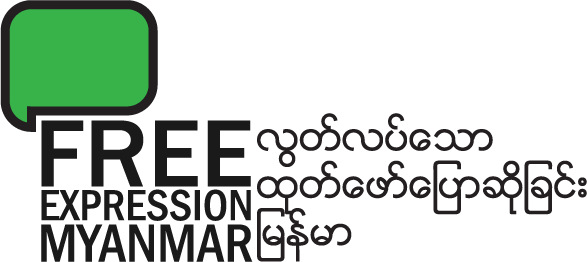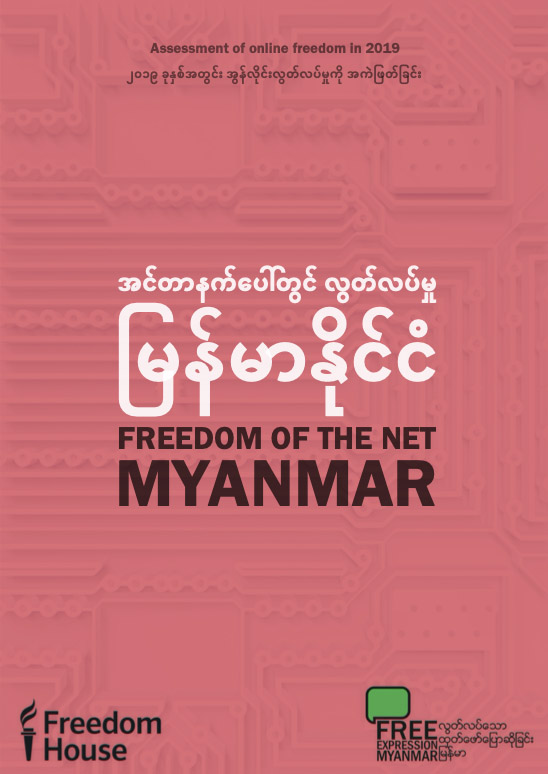New report: Freedom of the Net 2021 — အင်တာနက်ပေါ်တွင် လွတ်လပ်မှု မြန်မာနိုင်ငံ ၂၀၂၁
| 2019 | 2020 | 2021 | |
| Internet Freedom Status အင်တာနက်ပေါ်တွင် လွတ်လပ်မှု အခြေအနေ | Not Free လွတ်လပ်မှုမရှိ | Not Free လွတ်လပ်မှုမရှိ | Not Free လွတ်လပ်မှုမရှိ |
| A. Obstacles to Access (0-25 points) ရရှိအသုံးပြုနိုင်မှုအပေါ် အတားအဆီးများ (၀-၂၅ မှတ်) | 10 | 7 | 4 |
| B. Limits on Content (0-35 points) အကြောင်းအရာများကို ကန့်သတ်မှု (၀–၃၅ မှတ်) | 16 | 13 | 7 |
| C. Violations of User Rights (0-40 points) အသုံးပြုသူ အခွင့်အရေး ချိုးဖောက်မှုများ (၀-၄၀ မှတ်) | 10 | 11 | 6 |
| Total (0-100 points) စုစုပေါင်း (၀-၁၀၀) | 36 | 31 | 17 |
Internet freedom in Myanmar collapsed following the February 2021 military coup, marking the most severe decline ever documented in Freedom on the Net.
As part of its attempt to crush dissent and maintain power, the military junta shut down internet service, blocked social media platforms and websites, seized control of the telecommunications infrastructure, and ramped up intrusive surveillance. Despite these and other obstacles, including detentions and egregious physical violence, people in Myanmar continued to use digital tools to organize and voice opposition to the coup whenever possible.
Freedom of the Net is a partnership between Freedom House and FEM. The global report can be found at www.freedomonthenet.org. A Myanmar translation of the report will be available soon.
Key Developments, June 1, 2020 – May 31, 2021
- The military began shutting down internet services nationwide shortly before the February 2021 coup (see A3), and in the subsequent months it seized direct control over state-owned mobile service providers that accounted for more than half of all mobile subscriptions in the country. Parallel pressure on private-sector providers was so severe that Norway’s Telenor, one of the market leaders, sold off its mobile operations in Myanmar shortly after the coverage period (see A4).
- The ruling junta also assumed control over Myanmar’s telecommunications regulator, quashing any independence it previously had through a series of opaque directives and threats to staff (see A5).
- Military authorities ordered the blocking of social media platforms, online news outlets, and certain financial-services websites, with some remaining inaccessible at the end of the coverage period (see A3, B1, and B3). As of June 2021, the military had revoked the licenses of seven major media outlets that were reporting on anticoup protests, and telecommunications companies were ordered to block their websites (see B1 and B6).
- The coup leaders’ efforts to disrupt internet service and block online platforms were intended in part to suppress the organization of further protests. Authorities also banned virtual private networks (VPNs) and employed detentions and physical violence to punish users who expressed support for the anticoup movement. Nevertheless, citizens continued their attempts to mobilize via digital tools (see B8 and C4).
- The coup effectively nullified the constitution and the limited free expression protections it had offered, and the country’s Constitutional Tribunal—tasked with holding state officials accountable under the charter—was replaced by the military days after it seized power (see C1).
- In March and May 2021, new evidence supported suspicions that the military was using extraction and interception technology to surveil protesters. The military also suspended limited privacy protections provided by the Law Protecting the Privacy and Security of Citizens and issued an amendment to the Electronic Transactions Law that increased government access to personal data (see C5).
- Journalists, digital activists, and ordinary users were held in pretrial detention and sentenced to prison terms for their online activity in the months following the coup. One Democratic Voice of Burma reporter received a three-year sentence in May 2021 in connection with his coverage of protests (see C3). Physical violence and torture have become widespread in detention, and disappearances of or public attacks on prominent social media users served as additional deterrents to the expression of dissent online (see C7).



 Read the previous report, Freedom of the Net 2019 >>
Read the previous report, Freedom of the Net 2019 >>